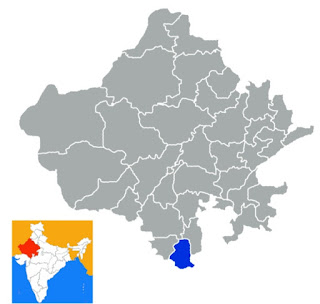Banswara, (literally ''the bamboo city'') was a Rajput feudatory state in Rajputana during the British India. It borders Gujarat and is bounded on the north by the native states of Dungarpur and Udaipur or Mewar, on the northeast and east by Pratapgarh, on the south by the dominions of Holkar and the state of Jabua and on the west by the state of Rewa Kantha. The state was founded by Maharawal Jagmal Singh in 1527 AD.
One rupee coin of Banswara, 1870 AD
Banswara state was about 72 km in length from north to south and 53 km from east to west having an area of 4160 square km. It was ruled by the Maharawals and named so because of the bamboo found in abundance in the forests.
Banswara State, located in southern Rajasthan
Map showing Banswara State
Flag
Flag of Banswara State
Emblem
Emblem of Banswara State
It was also known as the ''City of Hundred Islands'' or ''Cherapoonji of Rajasthan'', due to the highest rainfall in Rajasthan and presence of numerous islands on the Mahi river named ''Chachakota'' where the islands are located. Mahi river flows through Banswara. Banswara town was founded by King Bansiya Bhil.
The islands on Mahi river
Due to the inter-regional neighbourhood, the Vagdi culture has emerged as a mixture of Gujarat, Malwi, Rajasthani and Mewar cultures.
Banswara massacre is also known as Rajasthan's ''Jallianwala Bagh'', a little known event of the past. On 17 November 1913, Banswara district was witness to massacre of around 1500 tribals by the British after they opened fire on the tribals who had gathered on the Mangarh hillock situated in the Aravali mountains on the Rajasthan Gujarat border, echoing the Jallianwala Bagh massacre when 329 people were killed. The tribals were led by their leader Govind Guru who inspired them to throw off the yoke of British rule.
Govind Guru, 1874 -1931.
Govind Guru, influenced by social reformers like Dayanand Saraswat, launched the ''Bhagat Movement'' amongst the Bhils, asking them to adhere to vegetarianism and abstain from all types of intoxicants. The movement slowly took a political hue and turned into a movement against the oppressive policies of the British. They opposed taxes imposed and forced labour imposed in the states of Banswara, Dungarpur, Santrampur and Kushalgarh. Worried by the revolt, the Britishers decided to crush the uprising. From October 1913, Govind Guru asked his followers to gather at Mangarh hill. The British asked them to vacate Mangarh by 15 November, but they refused. On 17 November, the British forces under Colonel Sherton, Maj S Bailey and Capt E Stiley opened fire with cannons, guns and rifles and killed an estimated 1500 tribals in cold blood.
A plaque at Mangarh depicting the massacre of tribals by British forces in 1913
A portrait of the 1500 Bhils massacred in 1913Govind Guru was captured and imprisoned in Hyderabad jail, tried and sentenced life imprisonment, but owing to his popularity he was released in 1919 and exiled from his homeland. He settled in Limdi in Gujarat where he died in 1931.
Memorial in Mangarh dedicated to Gobind Guru
The site of the massacre is today known as Mangarh Dham, and the locals are demanding a national memorial be built there.
Mangarh Dham
Gobind Guru statue
Mangarh witnessed one of the bloodiest massacres in the history of British India.
Coinage of Banswara. During most of 19th century, Banswara used the ''Salim Shahi'' coinage of neighbouring Pratapgarh State. But in 1870, Maharawal Lakshman Singh, defying the British prohibitive order, introduced a series of crude coins in copper, silver and gold for use within the state.
The legend of these coins are in a secret script, said to have been invented by Lakshman Singh himself. The central word in these legends has been identified as ''Samsatraba'' in the longer form and ''Samba'' for the shorter form, a designation for the Hindu deity Shiva. The copper coins were used for circulation, but the gold and silver were produced mainly for presentation.
1/4 Rupee, Banswara State, Lakshman Singh, 1870 AD, silver, weight 2.0 gm, legend Samsatraba on both sides
1/2 Rupee, Banswara State, Lakshman Singh, 1870 AD, silver, weight 4.0 gm, legend Samsatraba on both sides






















Had never heard of this massacre in 1913.As usual well researched,thanks for the enlightment
ReplyDelete